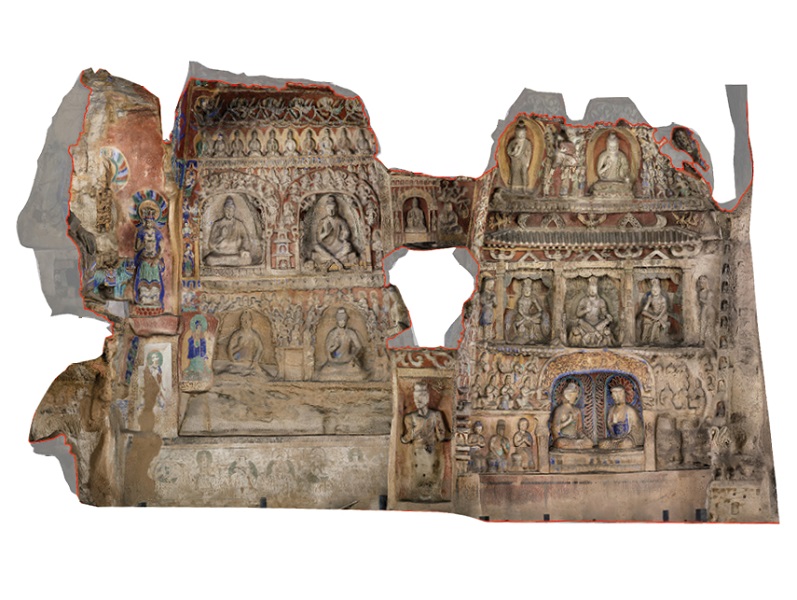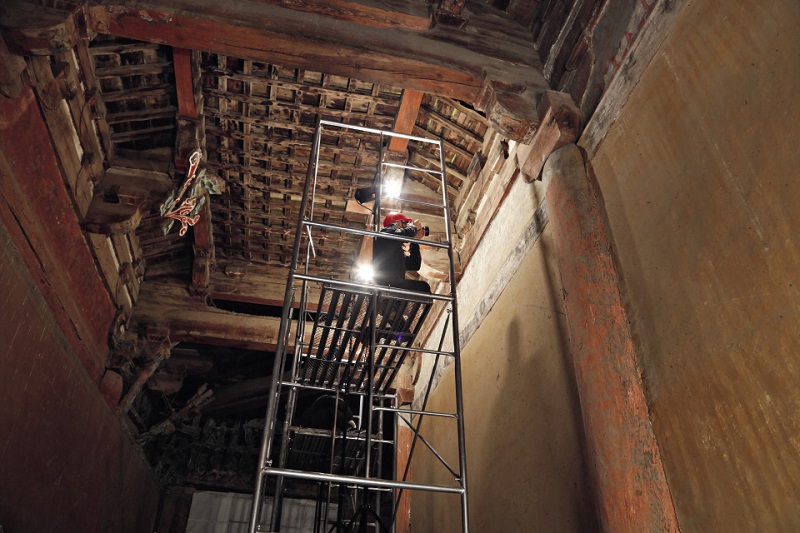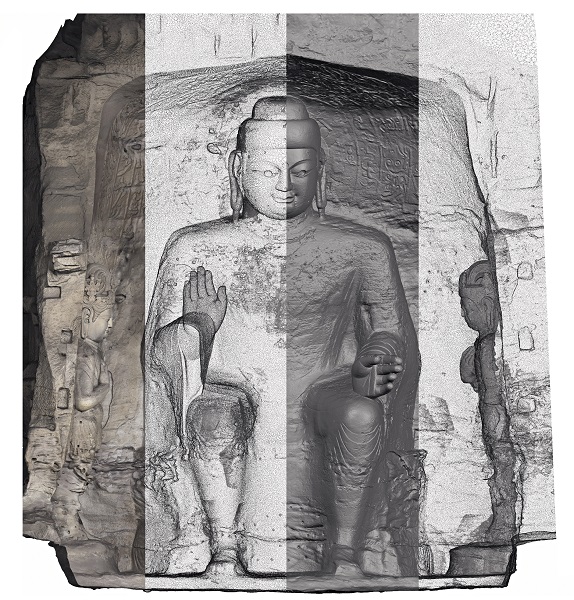Heritage Ark team, established in 2012 under the auspices of the Institute of Cultural Heritage Study at Zhejiang University, has worked in the field of digital protection for 10 years.

Team members working in Cave No. 100 of the Mogao Grottoes.
“‘Heritage Ark’, as the name suggests, means we are running in a race against time to store more information about cultural heritage,” said Professor Diao Changyu, tutor of the Heritage Ark Team of Zhejiang University. Diao and his colleagues all see themselves as “ferrymen” who help cultural heritage “cross the vicissitudes of millennial history to arrive safely at this point in time, and spread the seeds of Chinese civilization across the world.”
Over the past 10 years, the team has used 3D printing technology to reproduce and display cultural relics and bring them closer to the general public.

A section view of Cave No. 12 in Yungang Grottoes.
Starting in Dunhuang
The digitization of cultural heritage dates back to the late 1990s. Pan Yunhe, then president of Zhejiang University, first visited the Mogao Grottoes in Dunhuang in July 1997. Together with Fan Jinshi, then president of the Dunhuang Academy, he initiated the research on digitization and restoration of the Dunhuang murals, and set up an interdisciplinary research team to record and conserve those frescoes.
“Fan once said that the aging and disappearance of the Mogao Grottoes can only be delayed, not reversed,” said team leader Li Min. From 2010 to 2014, the research team of Zhejiang University comprising technologists and archeologists restored Cave No. 220 which dates back to the early Tang Dynasty (618-907). The Buddha statues in this cave retain the style of the early Tang Dynasty and are representative of that period. “The 1:1 scale reproduced cave and its configuration have been accurately reconstructed from three-dimensional data. The frescoes were spray-painted with rice paper, a high quality paper good for traditional Chinese painting and calligraphy, attached to the ground layer covering the earthen plaster. The color and texture of the original cave were therefore largely restored,” said Li.
Li’s Heritage Ark team was established in 2012 under the auspices of the Institute of Cultural Heritage Study of Zhejiang University, and has continued the work in the field of digital protection during the following 10 years.
So far, the team has completed 133 digitization projects after travelling 150,000 kilometers in 23 provinces across China, spending more than 150 days a year collecting data. “Apart from the caves, our team has also reproduced frescoes, tombs, and temples,” said Li, who cannot hide her pride of her team’s accomplishments, referring in particular to Yungang No.3 and No.12 caves, Longmen Grottoes, Tholing Temple Frescoes, Qingzhou Museum, and Dazu Rock Carvings. Among these locations, the reproduction of Cave No.12 of Yungang Grottoes is the world’s first movable 3D-printed grotto made by the team in cooperation with Yungang Grottoes Research Institute.
In this cave, also known as the Music Cave, paintings of celestial musicians can be seen above the north wall of the antechamber holding ethnic musical instruments, vividly reflecting the style and concert typical of imperial musical groups during the period of the Northern Wei Dynasty (386-534). The data found here are very precious for the study of the history of ancient Chinese music. This restored cave is 8.5 meters high, 12.2 meters wide, and 14.5 meters deep. “The reproduction work lasted for more than three years. It is not only the first time that 3D printing technology has been used in the world to conduct such a big project, but also the first time such a large-scale heritage item has become a portable exhibit. The 3D reconstruction error is less than 2 millimeters, which is the best performance in the field. With an assembly of 110 building blocks, it is easy and convenient to transport, making the first move for the Yungang Grottoes to tour around the world,” said Li.

Team members collecting image data of ancient buildings.
Overcoming Technical Difficulties
Li holds a Ph.D. from the Institute of Computer Science, Zhejiang University. Originally, the project was led by the research team of this institute, whose objective was to use digital technology to collect and preserve information on elements of cultural heritage. After the establishment of the university’s School of Art and Archeology in 2019, students and researchers of other disciplines like archeology and museology joined the project, opening up new possibilities of achieving transregional exhibitions of immovable cultural heritage by using 3D printing technology. This also is the “art + technology” model that the institute highlights.
There are 15 members on the team including Li, and they are subdivided into the archaeological, creative, and IT groups in the work chain to jointly carry out the project. Data collection, 3D modeling, 3D printing, and installation and exhibition are central tasks of this team’s digital protection and exhibition endeavor. “The hardest part is data collecting and modeling,” Li noted.
“Due to the complex condition and structure of the caves, we use 3D laser scanning technology combined with photogrammetry to collect data. In order not to damage the paint, the lighting cannot be too strong during the data collection. The challenge is this would alter the original colors,” said Li. As a result, the team developed the color calibration technology and managed to accurately reproduce the colors on the cave surface under various lighting conditions.
In addition, the team introduced deep learning technology for the first time to restore color to the damaged cave surfaces. Li took Yungang Cave No. 12 as an example, they had taken more than 50,000 photos over the course of three months using a geographic information system, drones, and archaeological photogrammetry. When it came to the part of modeling, they had to complete the calculation of 3,100 GB image information simultaneously. “Such a quantity of data exceeds the calculation limit of all 3D reconstruction software, ” Li noted. Eventually, they developed a big data platform to do parallel computing and accomplish this hyperscale 3D reconstruction.
Over the past few years, the team has continued to make technological breakthroughs. Zhejiang University’s independently developed fifth-generation high-fidelity equipment for collecting mural data is at the forefront of global technology. The photometric stereo 3D scanner they designed can realize the collection of highly reflective cultural relics at a leading international level.
According to Li, as 3D printing technology is constantly maturing, the Heritage Ark team will pay more attention to the use of virtual and augmented reality technologies to build a virtual space for cultural heritage. Meanwhile, more emphasis will be placed on innovation and reproduction technology in order to achieve a complete restoration of the texture of cultural relics.

Digital achievements of reconstructing a Buddhist figure at Cave No. 3 of Yungang Grottoes.
Inheriting Social Memory
The importance of this undertaking, according to Li, is that the team not only promotes education in domestic middle and primary schools, but also cooperates with top overseas universities to set up courses and programs, with the aim of raising public awareness to protect cultural heritage and increasing people’s respect for history. In doing so, it contributes to the inheritance and development of traditional Chinese culture.
The team has worked with Harvard University to develop a virtual reality program for the pyramids in Egypt, with the University College London to launch a program on the digital protection and promotion of the murals of endangered temples in Shanxi Province, and with Nepal’s Department of Archaeology for the digital study of the nine-story Basantpur Tower in Kathmandu and the training of local archaeologists.
“The digital exploration of cultural relics began much earlier overseas than in China, but most of them focus on the field of movable cultural relics, and they put less effort into immovable cultural relics, largely because many countries that are at the forefront of heritage conservation do not have as many immovable remains as China,” said Professor Diao, noting that China has a large number of grotto temples, wooden architecture, and frescoes. “All of these are extremely valuable cultural treasures of humanity,” he added.
“Sometimes it seems to us that heritage is highbrow art and mysterious because they are rare and difficult to access. Ordinary people may think they have nothing to do with them, but they are actually the fruits of wisdom of our ancestors, and relate to everyone,” Li noted. Her team uses digital technology to systematically record information about cultural heritage. They have established valuable digital archives for Chinese heritage and conserved the cultural relics, preserving the social memory they convey.